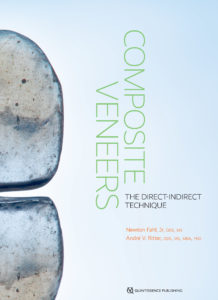Written by: Natalie Schawel
The history of dentistry is vast, and significant progress has been made to improve techniques used for composite resin restorations. Now, there are more options than ever, and the direct-indirect technique has proven itself to be a worthy competitor. Or, as Dr André V. Ritter, one author of Composite Veneers: The Direct-Indirect Technique (Quintessence, 2020), calls it, “a game-changer in terms of how we practice restorative dentistry today.”
Restorations began with the original direct technique, which has a number of benefits on its own. From color selection to final morphology, this technique allows the restorative process to be evaluated and controlled as much as possible. Because this technique is usually completed in one single appointment, it has long been the preferred composite resin method. However, the direct technique has notable drawbacks. Both functional and esthetic successful results depend largely on certain factors, such as the expertise of the operator, correct handling of layering techniques, and proper light curing techniques. Unfortunately, significant disadvantages to the restoration remain, including color instability, the potential for wear, and polymerization shrinkage.
To combat these challenges, the indirect technique was developed. By processing composite resins in the lab or chairside in the dental office, restorations done via the indirect technique lead to greater conversion of monomers to polymers. As a result, physical properties are improved, including increased wear resistance, improved hardness, polymerization shrinkage control, color stability, and enhanced biocompatibility. Once ceramics with higher-quality optical and mechanical properties were developed, however, the indirect technique for making composite resin veneers and anterior crowns became nearly obsolete.
A direct-indirect restoration is one in which the composite resin is sculpted directly on the tooth structure without any previous adhesive preparation.
Fast forward to the present day, when both clinicians and patients can benefit from the direct-indirect technique, which merges the advantages of both techniques. A direct-indirect restoration is one in which the composite resin is sculpted directly on the tooth structure without any previous adhesive preparation. After, it’s light activated, removed from the tooth, heat tempered, finished, and polished extraorally. Finally, it’s “bonded” or adhered indirectly in the mouth—all in one single appointment. Also referred to as the semidirect approach, the direct-indirect technique comes with many benefits. Dr Ritter explains: “The direct-indirect composite veneer technique combines advantages from each approach. The direct steps afford clinicians the ability to have control over the entire restorative procedure, from shade selection to composite layering. Meanwhile, the indirect steps allow enhanced control over contouring and marginal finishing, as well as optimal composite polymerization.”
The direct-indirect technique has revealed itself to have more advantages as well, such as lower costs for both clinician and patient, excellent quality of margins, and decreased time in the chair. “When the direct-indirect technique is fully mastered, clinicians can do two peg laterals or two-shaded veneers in less than 30 minutes, making it highly cost-effective to both dentist and patient,” says Dr Newton Fahl, Jr, coauthor of Composite Veneers.
“When the direct-indirect technique is fully mastered, clinicians can do two peg laterals or two-shaded veneers in less than 30 minutes, making it highly cost-effective to both dentist and patient,” says Dr Newton Fahl, Jr, coauthor of Composite Veneers.
Another critical aspect to restoration is the patient experience. Through the use of the direct-indirect technique, patient comfort is significantly improved: “The procedure is much more comfortable for the patient, as the clinician accomplishes of the procedure extraorally,” says Dr Ritter. Plus, the patient experience is also enhanced as a result of excellent final esthetics. Patients walk out happy and satisfied with the results.
Advancements like the direct-indirect technique have the power to benefit both clinician and patient, but this technique requires some extra diligence on the clinician’s part. As Dr Ritter explains, “It requires discipline, determination, and practice.” This technique is perfect for a clinician with an open mind, ready to accept new concepts into their clinical reality. The learning process may push clinicians out of their comfort zone, but the reward is sure to be worth it. The direct-indirect technique is therefore an approach that lends itself to comfort, quality, and durability, and it is an approachable technique for dentists looking to improve their expertise while enhancing their final product.
This technique is perfect for a clinician with an open mind, ready to accept new concepts into their clinical reality.
If you are interested in learning more about the direct-indirect technique, check out Composite Veneers: The Direct-Indirect Technique, which provides step-by-step protocols for the direct-indirect technique and systematically covers its many applications with specific layering strategies for each.
Direct-Indirect Technique from Samantha Smith on Vimeo.
 Newton Fahl, Jr, DDS, MS, received his DDS degree from Londrina State University in Brazil and received his Certificate in Operative Dentistry and MS from the University of Iowa. After returning to Brazil, he settled in Curitiba, where he maintains a private practice emphasizing esthetic and cosmetic dentistry. Dr Fahl is the scientific director of the Fahl Center, where he conducts courses on esthetic dentistry. He is a member of the American Academy of Esthetic Dentistry, a member and past president of the Society for Color and Appearance in Dentistry, and a founding member and past president of the Brazilian Society of Aesthetic Dentistry. He is also a MCG-Hinman Foundation fellow. Dr Fahl is the recipient of multiple awards and has published several articles on direct and indirect bonding techniques. He is on the editorial board of several peer-reviewed journals and is an active consultant for several manufacturers in the development and refinement of new materials and techniques.
Newton Fahl, Jr, DDS, MS, received his DDS degree from Londrina State University in Brazil and received his Certificate in Operative Dentistry and MS from the University of Iowa. After returning to Brazil, he settled in Curitiba, where he maintains a private practice emphasizing esthetic and cosmetic dentistry. Dr Fahl is the scientific director of the Fahl Center, where he conducts courses on esthetic dentistry. He is a member of the American Academy of Esthetic Dentistry, a member and past president of the Society for Color and Appearance in Dentistry, and a founding member and past president of the Brazilian Society of Aesthetic Dentistry. He is also a MCG-Hinman Foundation fellow. Dr Fahl is the recipient of multiple awards and has published several articles on direct and indirect bonding techniques. He is on the editorial board of several peer-reviewed journals and is an active consultant for several manufacturers in the development and refinement of new materials and techniques.
André Ritter, DDS, MS, MBA, PhD, graduated from the Federal University of Santa Catarina School of Dentistry in Brazil and later earned his MS and certificate in operative dentistry at the University of North Carolina (UNC), where he went on to become Graduate Program Director and Chair of the Department of Operative Dentistry at UNC. In 2016, he received the Thomas P. Hinman Distinguished Professor of Restorative Dentistry distinction. In 2018 he assumed the role of Executive Dean of the UNC Adams School of Dentistry, and he recently relocated to New York City where he started his tenure as Professor and Chair of the Department of Cariology and Comprehensive Care at the New York University College of Dentistry. In addition to DDS and MS degrees, Dr Ritter completed an MBA with specialization in Healthcare Management (Northeastern University, 2013) and a PhD in Dentistry (Universidade Positivo, 2019). His areas of research interest include caries diagnosis and management, conservative/minimally invasive restorative dentistry, esthetics, dental adhesion, and composite resin applications.


